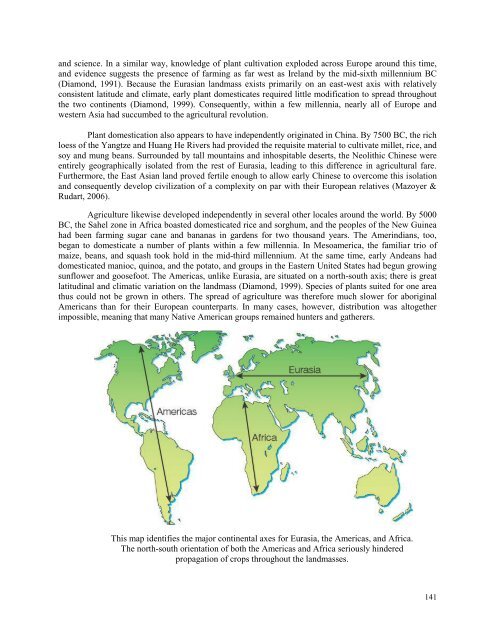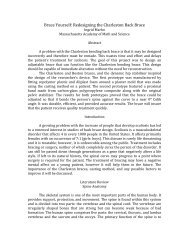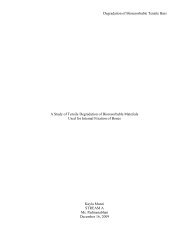Got Food? - the Scientia Review
Got Food? - the Scientia Review
Got Food? - the Scientia Review
You also want an ePaper? Increase the reach of your titles
YUMPU automatically turns print PDFs into web optimized ePapers that Google loves.
and science. In a similar way, knowledge of plant cultivation exploded across Europe around this time,<br />
and evidence suggests <strong>the</strong> presence of farming as far west as Ireland by <strong>the</strong> mid-sixth millennium BC<br />
(Diamond, 1991). Because <strong>the</strong> Eurasian landmass exists primarily on an east-west axis with relatively<br />
consistent latitude and climate, early plant domesticates required little modification to spread throughout<br />
<strong>the</strong> two continents (Diamond, 1999). Consequently, within a few millennia, nearly all of Europe and<br />
western Asia had succumbed to <strong>the</strong> agricultural revolution.<br />
Plant domestication also appears to have independently originated in China. By 7500 BC, <strong>the</strong> rich<br />
loess of <strong>the</strong> Yangtze and Huang He Rivers had provided <strong>the</strong> requisite material to cultivate millet, rice, and<br />
soy and mung beans. Surrounded by tall mountains and inhospitable deserts, <strong>the</strong> Neolithic Chinese were<br />
entirely geographically isolated from <strong>the</strong> rest of Eurasia, leading to this difference in agricultural fare.<br />
Fur<strong>the</strong>rmore, <strong>the</strong> East Asian land proved fertile enough to allow early Chinese to overcome this isolation<br />
and consequently develop civilization of a complexity on par with <strong>the</strong>ir European relatives (Mazoyer &<br />
Rudart, 2006).<br />
Agriculture likewise developed independently in several o<strong>the</strong>r locales around <strong>the</strong> world. By 5000<br />
BC, <strong>the</strong> Sahel zone in Africa boasted domesticated rice and sorghum, and <strong>the</strong> peoples of <strong>the</strong> New Guinea<br />
had been farming sugar cane and bananas in gardens for two thousand years. The Amerindians, too,<br />
began to domesticate a number of plants within a few millennia. In Mesoamerica, <strong>the</strong> familiar trio of<br />
maize, beans, and squash took hold in <strong>the</strong> mid-third millennium. At <strong>the</strong> same time, early Andeans had<br />
domesticated manioc, quinoa, and <strong>the</strong> potato, and groups in <strong>the</strong> Eastern United States had begun growing<br />
sunflower and goosefoot. The Americas, unlike Eurasia, are situated on a north-south axis; <strong>the</strong>re is great<br />
latitudinal and climatic variation on <strong>the</strong> landmass (Diamond, 1999). Species of plants suited for one area<br />
thus could not be grown in o<strong>the</strong>rs. The spread of agriculture was <strong>the</strong>refore much slower for aboriginal<br />
Americans than for <strong>the</strong>ir European counterparts. In many cases, however, distribution was altoge<strong>the</strong>r<br />
impossible, meaning that many Native American groups remained hunters and ga<strong>the</strong>rers.<br />
This map identifies <strong>the</strong> major continental axes for Eurasia, <strong>the</strong> Americas, and Africa.<br />
The north-south orientation of both <strong>the</strong> Americas and Africa seriously hindered<br />
propagation of crops throughout <strong>the</strong> landmasses.<br />
141
















